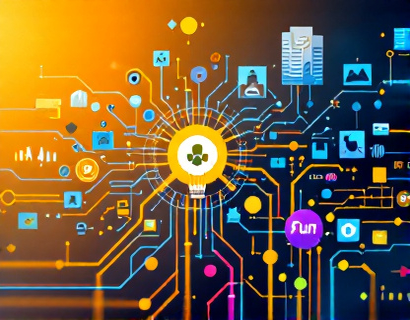Unlocking the Cosmos: A New Era of Personalized Astronomy Learning with AI
The field of astronomy has always been a realm of endless curiosity and discovery, inviting both students and enthusiasts to explore the vastness of the universe. Traditionally, learning about astronomy involved navigating through complex texts, static images, and limited interactive tools. However, with the advent of artificial intelligence and advanced educational technologies, a new era of personalized astronomy learning is dawning. This transformative journey leverages cutting-edge AI to create a tailored, immersive, and interactive experience, making the cosmos more accessible and understandable than ever before.
Personalized Learning Paths
The cornerstone of this new era is the personalized learning path offered by AI-driven platforms. By analyzing a user's knowledge level, interests, and learning pace, these systems curate a unique educational journey. For beginners, the platform starts with foundational concepts, gradually introducing more complex topics as the learner progresses. Advanced users, on the other hand, can dive straight into specialized subjects, such as exoplanet atmospheres or the dynamics of black holes. This adaptive approach ensures that every learner, regardless of their starting point, receives an education that is both challenging and engaging.
Interactive Resources and Visualizations
One of the most significant advantages of AI in astronomy education is the creation of interactive resources and visualizations. Traditional textbooks often struggle to convey the three-dimensional and dynamic nature of celestial bodies and phenomena. AI-powered tools can generate real-time 3D models of the solar system, galaxies, and cosmic events, allowing users to explore these environments from multiple angles. Interactive simulations enable learners to manipulate variables and observe the resulting changes, fostering a deeper understanding of astronomical concepts. For instance, users can adjust the mass of a star to see how it affects its lifecycle or simulate the collision of two galaxies to witness the resulting gravitational interactions.
Expert Insights and Community Engagement
AI-driven platforms also bridge the gap between learners and experts in the field. Through integrated Q&A systems and virtual mentorship, users can pose questions and receive insights from experienced astronomers and educators. This direct access to expert knowledge not only enhances learning but also inspires a sense of community among astronomy enthusiasts. Online forums and discussion boards facilitate the exchange of ideas, fostering a collaborative environment where learners can share discoveries, ask questions, and support one another. This community aspect is crucial in maintaining motivation and deepening engagement with the subject matter.
Real-Time Data and Current Events
Another feature that sets modern astronomy education apart is the integration of real-time data and current events. AI systems can pull in live data from telescopes and space missions, providing users with the latest observations and discoveries. This immediacy allows learners to follow ongoing research and participate in citizen science projects, contributing to real-world astronomical studies. For example, users can analyze data from the latest exoplanet discovery, helping to classify and characterize new worlds. This hands-on involvement not only enhances learning but also connects users to the global astronomical community, making them active participants in the pursuit of knowledge.
Gamification and Motivation
To further enhance the learning experience, AI-driven platforms incorporate elements of gamification. By turning educational tasks into games, these systems make learning more enjoyable and motivating. Users can earn badges, unlock achievements, and compete with peers in quizzes and challenges related to astronomy. This gamified approach not only makes the learning process more engaging but also encourages consistent practice and exploration. The sense of accomplishment from completing tasks and advancing through levels can significantly boost a learner's confidence and interest in the subject.
Customizable Learning Environments
Personalization extends beyond just the content to the learning environment itself. AI can adapt the interface and presentation style to suit individual preferences, whether a user prefers text-based information, visual aids, or auditory explanations. This flexibility ensures that each learner can engage with the material in the most effective way for their learning style. Additionally, the platform can adjust the difficulty and pace of the content based on the user's performance, ensuring a balanced and effective learning experience.
Accessibility and Inclusivity
The democratization of astronomy education is another key benefit of AI-driven platforms. These tools are designed to be accessible to a wide range of users, regardless of their background or location. High-quality educational resources are available online, breaking down barriers to entry and making astronomy accessible to anyone with an internet connection. For individuals with disabilities, AI can provide customizable options such as text-to-speech, screen readers, and adjustable text sizes, ensuring that everyone has the opportunity to explore the cosmos.
Future Prospects and Innovations
As AI technology continues to evolve, the potential for innovation in astronomy education is vast. Future developments may include more sophisticated AI assistants that can predict a user's next areas of interest based on their learning history, or advanced virtual reality (VR) experiences that immerse users in the cosmos. These advancements will further blur the line between virtual and real-world learning, providing even more realistic and engaging educational experiences. The integration of AI with other emerging technologies, such as blockchain for secure and transparent record-keeping of learning achievements, will also enhance the overall educational ecosystem.
Conclusion
The integration of AI in astronomy education marks a significant milestone in making the study of the universe more accessible, interactive, and personalized. By offering tailored learning paths, interactive resources, expert insights, and a supportive community, these platforms are revolutionizing the way we learn about the cosmos. As we embark on this transformative journey, the possibilities for discovery and understanding are limitless. The future of astronomy education is not just about learning; it's about experiencing the wonder of the universe in a way that was previously unimaginable.




